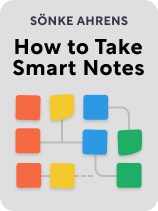

This article is an excerpt from the Shortform book guide to "How to Take Smart Notes" by Sönke Ahrens. Shortform has the world's best summaries and analyses of books you should be reading.
Like this article? Sign up for a free trial here .
Are your notes scattered all over the place? What is the most effective method for indexing notes?
An index is helpful for note-taking because it provides a quick reference to all the notes you’ve ever written. This way, you won’t struggle to find your notes while you’re conducting research.
Let’s look at how to index notes using the slip-box method, according to Dr. Sönke Ahrens.
How to Index Notes With the Slip-Box Method
Indexing notes is an important part of the slip-box system. The index is a document with a list of topics with references to the notes on which those topics are mentioned. You use it to navigate the collection of notes in your slip-box so that you can find the right idea when you need it. You can learn how to index your evergreen notes in one of two ways.
1. Create a new index entry whenever you notice that several evergreen notes in your slip-box all revolve around a single topic. This will consist of a keyword and the few notes most relevant to that keyword. Customize these keywords so they make sense to you and help you think: For example, a food writer with Note #30 that says “The best honey comes from Australia” might file that under the keywords “ingredient origins – honey.” An economist with that same note might file it under “beekeeping industry.”
(Shortform note: Similarly, Matuschak urges you to write your evergreen notes for your own eyes; they only have to make sense to you. Some people try to write evergreen notes as if they’ll publish them to save working time down the road—but doing this risks making the task so difficult that you never write them at all.)
2. Alternatively, another way to create an index is to link your evergreen note to an existing note. For example, if Note #31 reads, “Australian honey is very flowery,” you could link it to Note #30 using the method described in Step 5. Since Note #30 is still in the index, this technique ensures that you can still find Note #31—but it doesn’t overcrowd your index.
Potential Pitfalls of Ahrens’ Index
Ahrens’ way of creating an index differs from traditional indexes: It’s designed to help you find the high-level topics within your slip-box, whereas a traditional index would help you find every idea within your slip-box. As discussed, this is a feature, not a bug. But it may be frustrating if you’re looking for a specific note—a problem you can see firsthand if you go through Matuschak’s online slip-box.
Matuschak’s slip-box doesn’t require you to create an index per sé; rather, he has a page that lists what he’s currently working on and notes that act like index entries. For example, one note titled “Evergreen Notes” lists a brief explanation of evergreen notes and then links to several related notes. You can learn about his ideas as you organically follow links. However, if you, for example, close the system and return, you can only return to a specific note if you remember how you linked to it originally. This is an issue that could also arise if you’re looking for a note not linked to the index in Ahrens’s version of the slip-box.

———End of Preview———
Like what you just read? Read the rest of the world's best book summary and analysis of Sönke Ahrens's "How to Take Smart Notes" at Shortform .
Here's what you'll find in our full How to Take Smart Notes summary :
- Why traditional, prewriting note-taking methods don’t work
- How to use the slip-box system method of note-taking
- How to organize and file your notes






